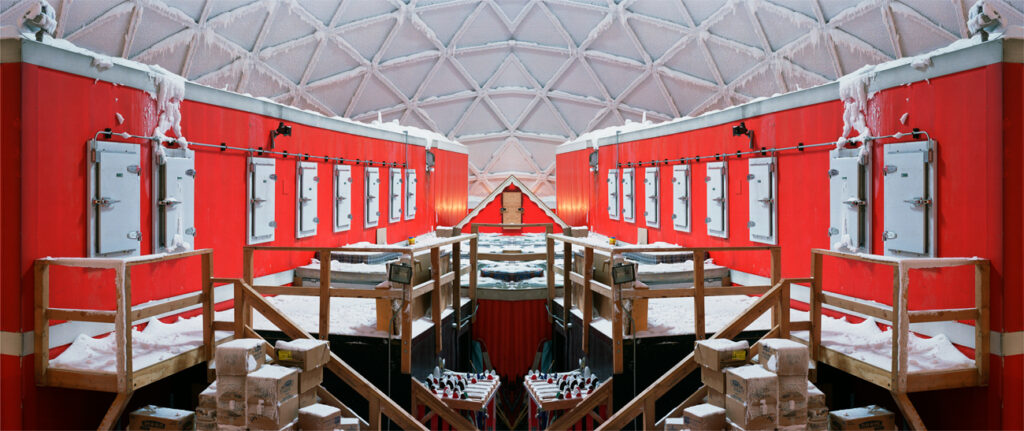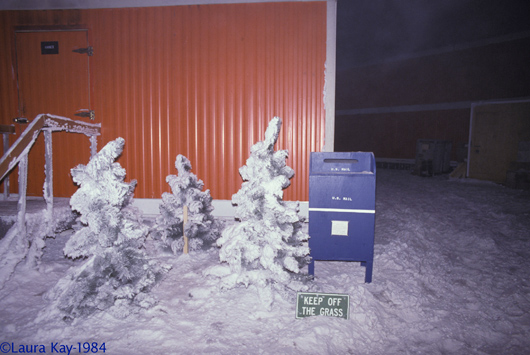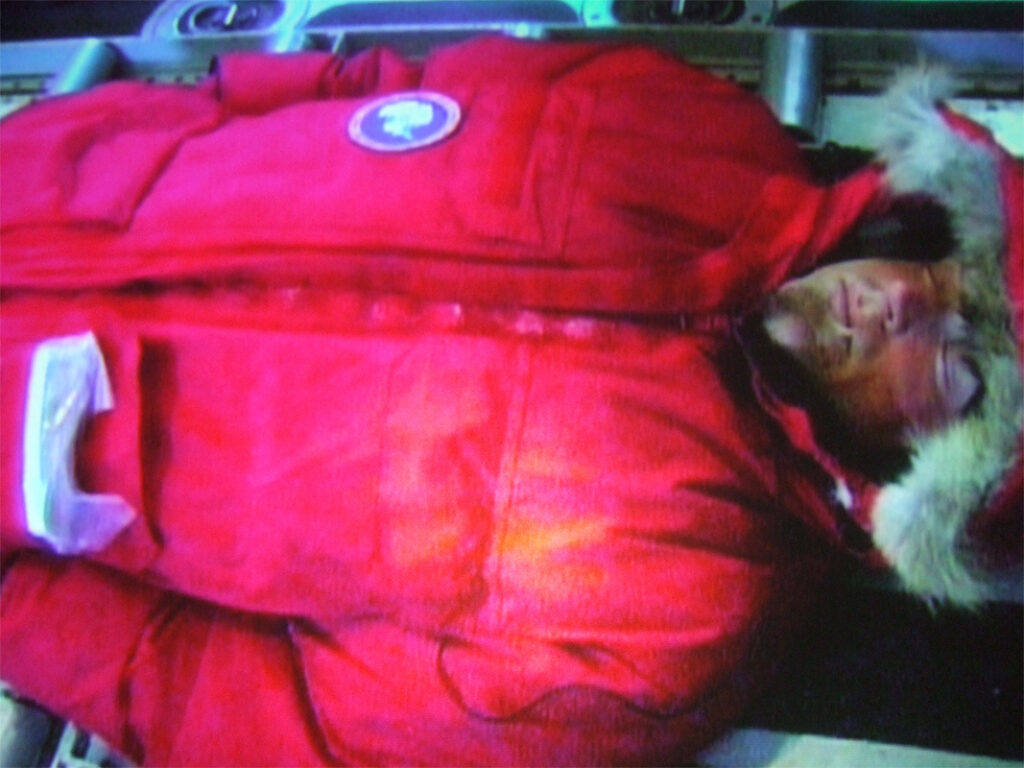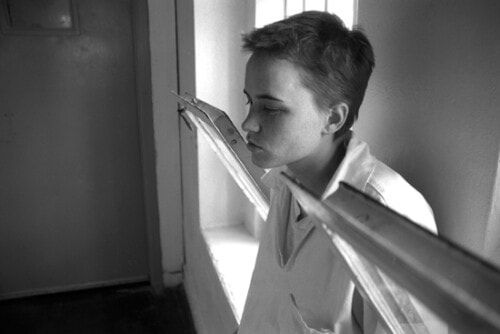
Dome Interior
digital print
Courtesy of the artist
Most of these images are achieved through straightforward photography, though some of them appear as if completely invented. The best example of this tendency is her only photograph of a strange empty domestic interior inside the Buckmister Fuller dome at the South Pole, showing two rows of red sleeping quarters facing each other that she altered slightly by flipping the negative, making the sleeping quarters mirror each other. Though the photograph is only slightly changed, the interior looks, in the mind of the viewer, alternatively like meat lockers, future cells for monks, or worse, those of a morgue (see Figure 11). The bright red sealed bunk spaces and the dome ceiling together are more easily imagined as occupied by a strange organized cult in a science fiction film than a real place where actual scientists live and work. Her slight digital manipulation of this space is done deliberately to make us wonder about “normative” gender relations in such a strange unearthly interior. Compare this work, for example, to Laura Kay’s image of the interior of the Fuller Dome in 1985 (see Figure 12). Here the dome interior is a funky non-corporate space, nonetheless made habitable, and inhabiting a specific identity and an appealing counter-culture aesthetic that makes it inviting.

Given the way that Samaras’ photographic work goes out of its way to deliberately play with our ideas of what we imagine Antarctica to be, it is significant that she titles her work after Phillip K. Dick’s semi-autobiographical VALIS trilogy based on his own claim to have had paranormal experiences. Dick’s VALIS trilogy is a study of the invasion of futuristic technology from the future into the present, established by supernatural intelligence, into the life of an ordinary, present-day man who is having a nervous breakdown. As Samaras indicates in her article in this special issue, her photographic work, like Dick’s novel, highlights some of the ways that scientific and technological rationality combats but fails to contain the forces of superstition and irrationality. This anxiety that creeps into her work and Dick’s rejects not the technological determinism of science but the confident ideology of scientific and technological universality and the neutrality of its representation. This also entails challenging masculinist modes of rationality, which was the subject of a fairly ironical photo and text project she made in the mid-1990s where she “corrected” the representations of earth culture sent out in 1977 by NASA and Carl Sagan to extraterrestrials on two U.S. Voyager Spacecrafts. 1

Underneath Amundsen-Scott Station
digital print
Courtesy of the artist
Samaras’ Antarctica project pursues this ironical approach by injecting something more unsettling and unearthly into what otherwise appear to be fairly neutral and objective images of Antarctica’s built environment, with its mostly anonymous industrial structures. 2 This comes through in her triptych of the “Amundsen-Scott Station Phase III” and the way the building, under construction, looks like a flimsy Hollywood set on ice rather than a place of habitation, and also in her photograph “Underneath Amundsen-Scott Station,” (see Figure 13) in which the building resembles an installation in space with its ultra-modern and sleek, seamless surfaces, while simultaneously the base of a fairly banal corporate structure. Like all her work, the deliberate play with the variable space between documentary and fiction sets her images apart from the public narratives and images of the Heroic Age of exploration and represents a shift from an image of the polar regions as representative of the sublime, to the present where the Antarctic is visualized as a place of fascinating terror, but this time as a result of man-made climate change and neo-liberal economics. In Samaras’ images, the Antarctic is no longer seen as simply an unearthly place, but also as a strangely fragile site, one where the ice itself becomes an important entity. The built environment seems vulnerable and unstable, as in her work, “Domes and Tunnel,” where the shifting pack ice will cover the Buckminster Fuller dome already slowly sinking in the permafrost, or in “Antennae Field South Pole,” (see Figure 14) an image of an empty Antarctic landscape that dwarfs a tiny radio antenna standing as the only sign of human habitation.

Antennae Field South Pole
digital print
Courtesy of the artist
Amelia Jones, the feminist art critic, in her 2006 book Self/Image: Technology, Representation and the Contemporary Subject, argues that the most important legacy of feminism is its politics of positionality across the visual. By that she means the importance of emphasizing the situatedness of positionality, of visuality, and of spectatorship. Samaras, who is interested in the social space of taking photographs and her performance behind the camera, is committed to recording her embodied relationship to Antarctica. For Samaras, that means highlighting the sense of dislocation and anxiety involved in living in such an extreme environment. In Gender on Ice, I pointed out how in the Scott narrative, the gendered, physical body is replaced by moral character, which provided the foundation on which masculinity becomes heroicized and the exterior world loses its concreteness. Samaras’ work is not about heroic masculinity but something much more displaced, related to both her positionality as well as the placelessness of the site that she photographs. Her detailed focus on the everyday brings us back to our senses, and in its focus on Antarctic architecture (both new and old) counters the romanticism and fantasies of transcendence through moral character that characterizes so much of the British discourse in Antarctica. At the same time, fantasy is not entirely absent as her work also evokes how alien the landscape is in Antarctica, when she, for example, foregrounds how uncontrollable the ice is as it swallows up buildings and signs of life in “Night Divide and Contrails” (see Figure 15) and in “Buried Fifties Station.”

Night Divide and Contrails
digital print
Courtesy of the artist
The two videos that Samaras made in Antarctica also move us away from narratives that erase or ignore the real life suffering, anxiety and sense of vulnerability and entrapment that is part of negotiating this extreme environment. The first is a single unedited static video, capturing a Weddell seal (average adult weight 400 pounds) noisily coming up for air through a hole in the ice. The other shows a male station hand asleep in the cargo bay area of a transport plane to Antarctica (see Figure 16). The seal jumps out at us in intervals and startles the viewer as she breaks through the icy surface just to breathe, reminding us of the effort it takes for all mammals, including humans, to breathe, and the kinship between human and non-human animals in this extreme climate. The man on the transport plane is quiet; the only noise is the sound of the airplane’s engine. However, as he sleeps and breathes quietly, he seems quite vulnerable. This image in particular is meant to remind us of how dependent the people, who are mostly absent from Samaras’ other photographs, are on machines and the built environment just to simply live in this extreme environment (see Figure 17). While the videos evoke the dependence of human beings on their machines and buildings, her clinical images of this anonymous built environment make us wonder what kinds of human beings could inhabit this secluded, somewhat alien, non-domestic world. You might say that her video, with the mummy-like man sleeping in suspended animation, captures the ghosts moving through these spaces, even though this peaceful image seems to be the antithesis of the picture of hardship and suffering that provided a heroic dimension to polar exploration from an earlier age. Samaras reminds us that in the post-heroic age, while the region is increasingly more accessible, the same anxieties of managing the forbidden climate remain today.

Video still from Untitled (Ross Ice Shelf, Antarctica)
digital print
Courtesy of the artist

Video still from installation Sleeping Man on Transport Plane
digital print
Courtesy of the artist
- “A Partial Correction to the Representations of Earth Culture Sent Out to Extraterrestsrials on the US 177 Voyager Interstellar Space Probes” was first exhibited at New Langton Arts in San Francisco in 1994.The exhibit was curated by Nancy Gonchar and there was a catalogue to accompany the exhibit. Also see, Connie Samaras, “Abduction Experience: Impression of Abduction Narratives read by the Corrector, Recorded 17-19 May 1994, L.A, CA, USA,” Processed Lives: Gender and Technology in Everyday Life. Ed. Jennifer Terry. New York: Routledge, 1997: 200-213.[↑]
- Samaras draws on a tradition of aesthetics associated with a tradition of a male-coded photography by deploying a dead pan photographic style associated with the work of contemporary German photographers Andreas Gursky and Candida Höfer, former students of Bernd and Hilla Becher who were active from the late 1950s to the late 1990s. Whereas Gursky is drawn to large, anonymous, urban spaces—high-rise facades at night, office lobbies, and stock exchanges—Höfer makes large-format photographs of empty interiors and social spaces that capture what she calls the “psychology of social architecture.” For an extended discussion of Samaras’ work in relation to the Bechers as well as Gursky and Höfer see: Kristina Newhouse, “Connie Samaras: V.A.L.I.S..” X-TRA Contemporary Art Quarterly 10:4 (Summer 2008).[↑]



